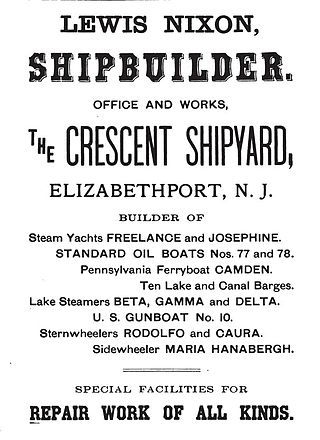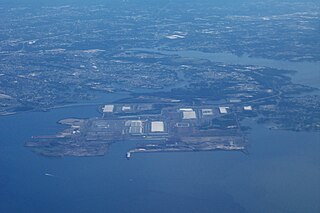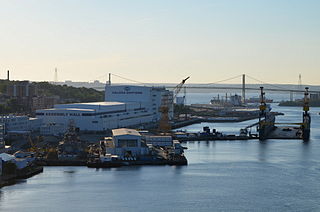Related Research Articles

Vigor Shipyards is the current entity operating the former Todd Shipyards after its acquisition in 2011. Todd Shipyards was founded in 1916, which owned and operated shipyards on the West Coast of the United States, East Coast of the United States and the Gulf. Todd Shipyards were a major part of the Emergency Shipbuilding Program for World War II.

Crescent Shipyard, located on Newark Bay in Elizabeth, New Jersey, built a number of ships for the United States Navy and allied nations as well during their production run, which lasted about ten years while under the Crescent name and banner. Production of these ships began before the Spanish–American War and occurred far before the outbreak of World War I. Arthur Leopold Busch, a recent emigre from Great Britain, started the yard with former Navy Lt. Lewis Nixon in January 1895. Both men previously worked for William Cramp & Sons in Philadelphia. Both Nixon and Busch were regarded to be amongst the best in their respected fields - and what they did at this time - as designers and builders of the latest, most advanced types of ships.

Union Iron Works, located in San Francisco, California, on the southeast waterfront, was a central business within the large industrial zone of Potrero Point, for four decades at the end of the nineteenth and beginning of the twentieth centuries.

Bethlehem Steel Corporation Shipbuilding Division was created in 1905 when the Bethlehem Steel Corporation of Bethlehem, Pennsylvania, acquired the San Francisco-based shipyard Union Iron Works. In 1917 it was incorporated as Bethlehem Shipbuilding Corporation, Limited.

Fore River Shipyard was a shipyard owned by General Dynamics Corporation located on Weymouth Fore River in Braintree and Quincy, Massachusetts. It began operations in 1883 in Braintree, and moved to its final location on Quincy Point in 1901. In 1913, it was purchased by Bethlehem Steel, and later transferred to Bethlehem Shipbuilding Corporation. It was sold to General Dynamics in 1963, and closed in 1986. During its operation, yardworkers constructed hundreds of ships, for both military and civilian clients.

W. & A. Fletcher Co. was an American manufacturer of marine boilers and steam engines for steamboats on the Hudson, in the Great Lakes, Long Island Sound, and elsewhere in the late 19th and early 20th centuries. The company was founded in 1853 and associated with development of steam powered ships from the original crude efforts.
Maryland Steel, in Sparrows Point, Maryland, US, was founded in 1887. It was acquired by Bethlehem Shipbuilding Corporation in 1916 and renamed as the Bethlehem Sparrows Point Shipyard. The shipyard was sold in 1997 to Baltimore Marine Industries Inc. In 2012, it was owned by Barletta Industries, which had converted it to the Sparrows Point Shipyard and Industrial Complex. As of 2021, it is owned by Sparrows Point Terminal, LLC and has been renamed Tradepoint Atlantic.

The Federal Shipbuilding and Drydock Company was a United States shipyard in New Jersey active from 1917 to 1948. It was founded during World War I to build ships for the United States Shipping Board. Unlike many shipyards, it remained active during the shipbuilding slump of the 1920s and early 1930s that followed the World War I boom years. During World War II, it built merchant ships as part of the U.S. Government's Emergency Shipbuilding program, at the same time producing more destroyers for the United States Navy than any yard other than the Bath Iron Works. Operated by a subsidiary of the United States Steel Corporation, the shipyard was located at Kearny Point where the mouth of the Hackensack River meets Newark Bay in the Port of New York and New Jersey.

Sparrows Point is an industrial area in unincorporated Baltimore County, Maryland, United States, adjacent to Edgemere. Named after Thomas Sparrow, landowner, it was the site of a very large industrial complex owned by Bethlehem Steel, known for steelmaking and shipbuilding. In its heyday in the mid-20th century, it was the largest steel mill in the world. The site of the former Bethlehem Sparrows Point Shipyard and steel mill is now renamed Tradepoint Atlantic in a revitalization program to clean up the environment and make it one of the largest ports on the East Coast of the United States. Today Sparrows Point is home to many distribution centers, fulfillment centers, training lots, storage lots, and the like, including those operated by Under Armour, Amazon, Home Depot, Volkswagen, and McCormick & Company.

The Seattle-Tacoma Shipbuilding Corporation was an American corporation which built escort carriers, destroyers, cargo ships and auxiliaries for the United States Navy and merchant marine during World War II in two yards in Puget Sound, Washington. It was the largest producer of destroyers (45) on the West Coast and the largest producer of escort carriers of various classes (56) of any United States yard active during World War II.

The Halifax Shipyard Limited is a Canadian shipbuilding company located in Halifax, Nova Scotia.
The Morse Dry Dock and Repair Company was a major late 19th/early 20th century ship repair and conversion facility located in New York City. Begun in the 1880s as a small shipsmithing business known as the Morse Iron Works, the company grew to be one of America's largest ship repair and refit facilities, at one time owning the world's largest floating dry dock.
The Western Dry Dock and Shipbuilding Company was a shipyard that operated at Port Arthur, Ontario, now part of Thunder Bay, on Lake Superior from 1911 to 1993. The shipyard was established in 1909 and renamed in 1916 as the Port Arthur Shipbuilding Company. The yard closed in 1993. It reopened as a repair yard Lakehead Marine and Industrial, however that venture failed in 2014. As of 2016, the shipyard was purchased by Heddle Marine. It is operated by Heddle Marine in partnership with Fabmar Metals Inc, of Thunder Bay. The venture focuses on ship repair services and winter layup options.

The Seattle Construction and Drydock Company was a shipbuilding company based in Seattle, Washington. Between 1911 and 1918, it produced a substantial number of ships for both commercial and military uses. In the beginning of the 20th century, until its significance was diluted by the emergence of a number of shipyards during the World War I shipbuilding boom, it was the largest of its kind in Seattle and one of the few significant ship yards along the West Coast of the United States, second only to the Union Iron Works in San Francisco.

General Engineering & Dry Dock Company was a shipbuilding and ship repair company in Alameda, California that was active from the 1920s through the 1940s. The company built ships for the Southern Pacific Railroad and the United States Coast Guard in the late 1920s and early 1930s and took part in the World War II shipbuilding boom, making diesel-propelled steel hulled auxiliaries for the United States Navy, primarily oceangoing minesweepers.

Bethlehem Atlantic Works of East Boston, Massachusetts, was a shipyard in the United States from 1853 until 1984. It was owned by the Bethlehem Shipbuilding Company. It is located directly to the west of the East Boston Immigration Station. The company's offices were in the Atlantic Works Warehouse, built in 1893.

Bay Shipbuilding Company (BSC) is a shipyard and dry dock company in Sturgeon Bay, Door County, Wisconsin. As of 2015, Bay Ships was a subsidiary of Fincantieri Marine Group and produces articulated tug and barges, OPA-90 compliant double hull tank ships and offshore support vessels. It also provides repair services to the lake freighter fleet. In the past the shipyard located in Sturgeon Bay has operated under several different names and traces its history back to 1918.

Bethlehem Key Highway Shipyard started as William Skinner & Sons in downtown Baltimore, Maryland in 1815. In 1899 the shipyard was renamed Skinner Shipbuilding & Dry Dock Company. Also at the site was Malster & Reanie started in 1870 by William T. Malster (1843–1907). In 1879 Malster partnered with William B. Reaney (1808-1883). In 1880 Malster & Reanie was sold and renamed Columbian Iron Works & Dry Dock Company. Malster & Reanie and Skinner Shipbuilding & Dry Dock Company merged in 1906, but remained as Skinner Shipbuilding. In 1914 the company was renamed Baltimore Dry Dock & Shipbuilding Company. Baltimore Dry Dock & Shipbuilding Company sold to Bethlehem Steel in 1922, becoming part of Bethlehem Shipbuilding Corporation. Bethlehem Steel operated the shipyard for ship repair, conversion and some ship construction. Bethlehem's main ship construction site was across the harbor at Bethlehem Sparrows Point. Bethlehem Key Highway Shipyard was known as the Bethlehem Upper Yard located north-east side of Federal Hill. Bethlehem Fort McHenry Shipyard located on the west side of Locust Point peninsula was known as the Lower Yard, near Fort McHenry.

Bethlehem Beaumont Shipyard was a shipyard in Beaumont, Texas that opened in 1948. The yard is located on an island in the Neches River and upstream of the Sabine Pass that grants access to the Gulf of Mexico. The deep-water port shipyard was founded in 1917 as the Beaumont Shipbuilding & Dry Dock Company. Beaumont Shipbuilding & Dry Dock Company started as a World War I Emergency Shipbuilding Program yard.

Bethlehem Staten Island also called Bethlehem Mariners Harbor was a large shipyard in Mariners Harbor, Staten Island, New York. The shipyard started building ships for World War II in January 1941 under the Emergency Shipbuilding Program and as the result of the Two-Ocean Navy Act of July 1940. The shipyard was part of the Bethlehem Shipbuilding Corporation which built ships for the United States Navy, and the United States Maritime Commission. Bethlehem Steel purchased the shipyard in June 1938 from United Shipyards. Bethlehem Shipbuilding Corporation closed the shipyard in 1959. The propeller factory and foundry continued operation for 10 more years at the site. Since 1980 the site is the May Ship Repair Contracting Corporation next to Shooters Island at the southern end of Newark Bay, off the North Shore.